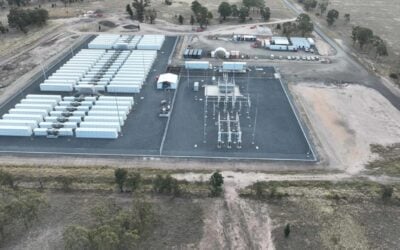
We hear from Modo Energy about the latest developments for BESS revenues in the ERCOT, Texas market, including how numerous trends are making optimising projects increasingly complex.
As Energy-Storage.news wrote in a separate article yesterday (Premium access), ERCOT now has nearly 5GW of large-scale BESS online, with that number set to grow substantially by the end of the year too.
Investors, IPPs and developer-operators there are capitalising on some of the highest revenues anywhere in the world, but the picture has shifted this year as market intelligence firm Modo Energy’s ERCOT market lead Brandt Vermillion explained.
Revenues down on last year
Vermillion said that due to a combination of factors revenues in 2023 haven’t been as high as last year.
Try Premium for just $1
- Full premium access for the first month at only $1
- Converts to an annual rate after 30 days unless cancelled
- Cancel anytime during the trial period
Premium Benefits
- Expert industry analysis and interviews
- Digital access to PV Tech Power journal
- Exclusive event discounts
Or get the full Premium subscription right away
Or continue reading this article for free
“Summer 2023 weather was pretty extreme meaning a significant jump in overall demand as well as net demand. And that drove some significant overall energy price increases and ancillary service prices last summer, resulting in some pretty significant 2023 revenues for storage. The ballpark for the year was about US$200,000 per MW,” he said.
“2024 hasn’t necessarily been the same. We’ve had a fairly mild summer so far. Peak demand is definitely up year-over-year but net demand isn’t. The data isn’t finalised yet, but I don’t think revenues for June will be all that significant either, compared to last year.”
(Net demand is peak demand minus solar generation, and is the more relevant of the two metrics in terms of scarcity, which is pivotal to BESS revenues.)
However, there could still be an uplift with some of the hottest periods – and peak demand with it – still to come in August and September.
“A lot of that is really just going to be dependent on what happens with the weather, which is ultimately the main driver. It’s about how high demand gets and how much congestion is on the system,” Vermillion said.
Revenues in ERCOT becoming more concentrated and a changing stack
One big trend is for revenues to become more ‘spikey’ throughout the year, Vermillion said.
“One thing we are seeing is a continuation of a trend from 2022 and 2023 towards revenues becoming every more concentrated into a small number of days. That means an increase in volatility where prices are either going through the roof or batteries aren’t making much money at all.”
That means even more is resting on trading decisions and deciding when to bid into different markets, especially as the market shifts towards energy trading.
“Generally, high energy prices means high ancillary service prices. If scarcity is higher than expected by the day-ahead market, then people will do more energy arbitrage instead of ancillary services. One day in April saw BESS earn nearly two-thirds of revenues from energy arbitrage,” Vermillion said.
“It’s a big ongoing challenge for asset owners and optimisers to understand which of the real-time and day-ahead markets will finish ahead of the other. It’s an additional layer to the optimisation challenge and is becoming more and more prevalent. Combined with revenues becoming more concentrated into fewer days, that intensifies the pressure on getting it right. Getting it right in terms of whether predicted scarcity will show up, and whether to bid into the real-time or day-ahead market.”
Market saturation
One big question in ERCOT has been when the ancillary services market will saturate as the BESS buildout accelerates. In the UK, last year saw revenues fall by more than 50% as BESS increasingly set the clearing price for ancillary services, sending shockwaves through the industry.
As others have told Energy-Storage.news, there is some evidence this is already starting to happen in ERCOT, as Vermillion explained.
“I wouldn’t say that saturation has happened yet, but it’s happening. In the last few years we’ve definitely seen a decrease in the price of ancillary services relative to energy prices. That is ultimately resulted in us seeing more revenues for BESS coming from energy arbitrage.”
“Asset owners are allocating less and less of their capacity to ancillary services, perhaps in an effort to get ahead of the game in the knowledge that energy arbitrage will be the name of the game at some point. And BESS deployments aren’t slowing and that will increase that gap.
Last year energy arbitrage was around 15% of revenues, whereas this year so far it’s well above 20%, possibly approaching 25-30%, Vermillion added.
Third-party optimisation of BESS in ERCOT
The other question is what this all means for optimisation of BESS in ERCOT. In the UK, it’s been typical for an outside company to do route-to-market (RTM) and optimisation and trading on projects, while in ERCOT this has primarily been done in-house.
“Who is optimising what, is hard to know because it isn’t necessarily public information. I would agree that the majority of BESS in ERCOT are being optimised in-house. A lot of the time they have their own trading arm. They may not be the ones doing the actual physical operations, but they are usually the ones making the decisions and setting the strategy,” Vermillion said.
“I would say it might be changing, to some extent. Habitat Energy made a pretty big announcement. I don’t know if third-party optimising will become the majority though. A lot of the big owners have been pretty successful. Jupiter Power has been one of the highest performing revenue wise, and they do everything in-house.”
Energy-Storage.news’ publisher Solar Media will host the 1st Battery Asset Management Summit USA in San Diego on 12-13 November 2024. Featuring a packed programme of panels, presentations and fireside chats from industry leaders focusing on Connecting Asset Owners and Optimizers to Maximize Strategies for Storage Assets. View the website today.





